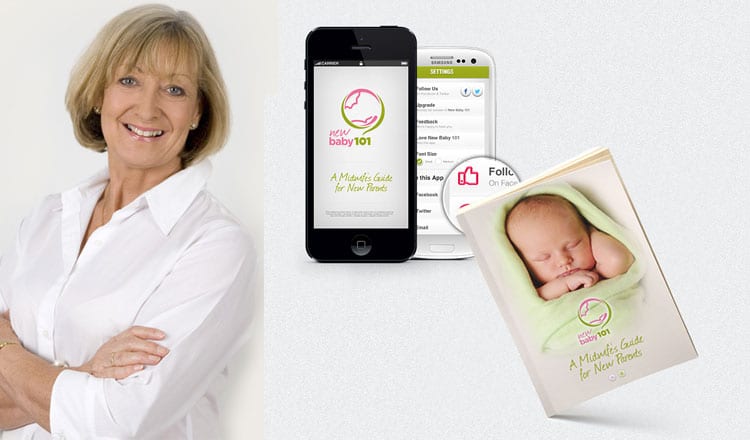Flow, latching, suckling… breastfeeding comes easy to some, but is much trickier for others. Learn how to decode those baby cues, burps and baby bites with this advice from Midwife Lois Wattis…
Midwife Lois Wattis has been at the coalface of new parenting for more than 18 years, so she knows a thing or two about newborns and parent’s concerns. In her new eBook and App, New Baby 101 – A Midwife’s Guide for New Parents, Lois puts all that wisdom into an essential how-to guide for parents, addressing their most frequently asked questions and concerns. “I work on a maternity ward in a specialist Lactation Consultancy role with new parents and newborns, so I am well aware of the pressure parents experience when they have all the responsibilities of caring for their newborn,” explains Lois. “I wrote this book because I know the questions new parents ask, and how difficult it is for them to retain all the information they need in the few days they are in hospital. New Baby 101 – A Midwife’s Guide For New Parents is for parents negotiating the steep learning curve encountered during the early weeks of parenting a new baby, providing them with detailed and reliable guidance.”
Here’s her advice on breastfeeding baby…
How do I know my breastfed baby is getting enough food?
During an effective breastfeed mothers can hear baby swallowing and can count how many sucks baby does between swallows to gauge how well he is drinking. Baby’s cheeks should appear full and his lips should be curled outwards. If baby’s cheeks are dimpling inwards as he sucks, he does not have his tongue positioned correctly and he is not really feeding effectively.
How well the baby fed is more important than how long baby was at the breast. A baby can take a large volume of milk in a short time (5 or 10 minutes), if he is optimally positioned and attached, whereas a poorly positioned and attached baby may drink far less milk even when he has been at the breast for 30 minutes or more.
It is a normal pattern of feeding for baby to suck and pause, and as baby gets fuller the sucks get shorter and the pauses get longer. As baby nears the end of that phase of the feed he may rest as he pauses, his chin may tremble or mum may feel little fluttery sucks. Baby may partially or fully release his latch, and appear satisfied and probably sleepy.
Mother can also be guided by whether her breast feels softened after a feed, which indicates how much milk baby drank. Each breastfeed is usually comprised of a few instalments. Young babies particularly need to take each ‘meal’ in a few stages, with rest times in between each stage to allow comfortable digestion. Always return baby to the starting breast at least once before offering the second breast. Baby will show you he is full by appearing comfortable and satisfied, and probably look ‘milk drunk’ and sleepy. If he settles easily after burping and nappy changes if needed, he has had enough. If he doesn’t, he probably needs a bit more breastfeeding – sometimes it is only a few more minutes which satisfies baby. Trust your baby’s cues, and you will soon gain confidence when judging whether he has completed his breastfeed.
Want more advice from midwife and author of New Baby 101 – A Midwife’s Guide For New Parents, Lois Wattis? Keep a look out for the upcoming stories on…
Why is it so important to keep track of baby’s output?
Do I need to burp my baby after every feed?
My baby is Jaundiced – what should I do?
Why is it difficult to get my baby boy circumcised?
About Lois
Lois Wattis has been a Midwife for 20 years, a Registered Nurse for 24 years and an International Board Certified Lactation Consultant for 15 years. Lois also practiced as an accredited Independently Practising Midwife (IPM) in Western Australia for five years. Lois currently works at Nambour General Hospital as a specialist Clinical Midwife Lactation Consultant as well as providing private Lactation Consultancy services via ‘Babymooon Home Visits’ on the Sunshine Coast Qld www.birthjourney.com
Over the past decade Lois has provided education for midwives via Australian and international professional journals, and as a speaker at midwifery and parenting conferences around Australia. Lois’ contribution to midwifery education was acknowledged at the International Confederation of Midwives in 2005 when she was awarded a Fellow of the Australian College of Midwives.
Lois’ experience is broad, and her focus is now on supporting parents negotiating the steep learning curve as they care for their new baby. Lois’ book which includes 5 videos “New Baby 101 – A Midwife’s Guide for New Parents” is available from her website www.newbaby101.com.au and her New Baby 101 App is available for smartphones via Google Play and iTunes Appstore.
Buy the eBook and download the App
New Baby 101 – A Midwife’s Guide For New Parents by Lois Wattis. The free App is created in FAQ format, giving comprehensive answers related to the nine topics covered in my eBook. The App includes two free ‘How-to’ videos, and the content can be upgraded to answer more than 50 FAQs for $6.99. You can download the free App on your smartphone via Google Play or iTunes. The eBook includes three additional ‘How-to’ videos.
Visit www.newbaby101.com.au for details.
Has Lois helped answer some of your newborn questions? Tell us your thoughts in the comments below!








